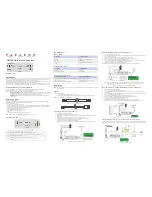
2.6 How the TPS module works
After decoding QPSK- or 8PSK-modulated signals, the demodulated data stream
can be accessed via the integrated TPS module. This data stream, also called
transport stream, contains several stations in all their components (video, audio,
data and service information), which can be changed using the TPS module.
The individual functions
Station filter
Individual stations can be deleted. This reduces the data rate and, consequently,
the output symbol rate required. Additionally stations of the different transport
streams can be assembled to a new transport stream.
Stuffing
The transport stream is padded using what is known as zero data. This ensures
a steady and constant output symbol rate.
Changing the NIT
The transport stream contains data in the form of tables which the receivers eval-
uate and require for convenient use. The TPS module can adjust the “Network
Information Table” (NIT) to accommodate the new station data. The “NIT” con-
tains data which is required by the set-top box for the automatic search feature.
Changing the operator ID (CAT)
Some network operators transmit an operator ID in the data stream (e.g. visAvi-
sion). By changing the CAT the operator ID can be adjusted to the demands.











































